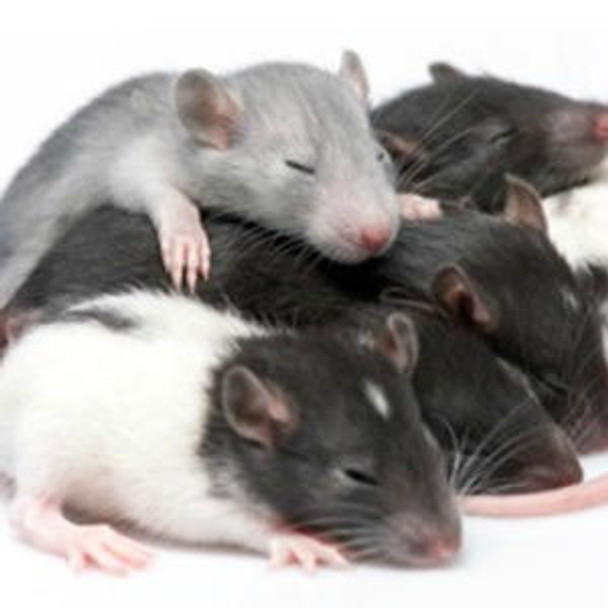Rat Transcription factor GATA-4 (Gata4) ELISA Kit
- SKU:
- RTEB0246
- Product Type:
- ELISA Kit
- Size:
- 96 Assays
- Uniprot:
- P46152
- ELISA Type:
- Sandwich
- Synonyms:
- GATA4, GATA binding protein 4, GATA-binding factor 4, MGC126629, transcription factor GATA-4
- Reactivity:
- Rat
Description
| Product Name: | Rat Transcription factor GATA-4 (Gata4) ELISA Kit |
| Product Code: | RTEB0246 |
| Alias: | Transcription factor GATA-4, DNA-binding protein GATA-GT2, GATA-binding factor 4, Gata4 |
| Uniprot: | P46152 |
| Reactivity: | Rat |
| Range: | Please contact us for more information |
| Detection Method: | Sandwich |
| Size: | 96 Assay |
| Storage: | Please see kit components below for exact storage details |
| Note: | For research use only |
| UniProt Protein Function: | GATA4: a conserved and ubiquitous member of the GATA family of zinc-finger transcription factors. Members of this family recognize the GATA motif which is present in the promoters of many genes. This protein is thought to regulate genes involved in embryogenesis and in myocardial differentiation and function. May regulate a set of cardiac-specific genes and play a crucial role in cardiogenesis. Defects are a cause of atrial septal defect 2 (ASD2). ASD2 is an autosomal dominant condition with atrial septal defect and other congenital heart disease but no conduction defects or noncardiac abnormalities. |
| UniProt Protein Details: | Protein type:Motility/polarity/chemotaxis; Transcription factor Chromosomal Location of Human Ortholog: 15p12 Cellular Component: nuclear body; nuclear chromatin; nucleus; RNA polymerase II transcription factor complex; transcription factor complex Molecular Function:activating transcription factor binding; chromatin binding; co-SMAD binding; DNA binding; DNA binding transcription factor activity; NFAT protein binding; protein kinase binding; sequence-specific DNA binding; transcription coactivator activity; transcription factor activity, RNA polymerase II distal enhancer sequence-specific binding; transcription factor binding; transcription regulatory region DNA binding; zinc ion binding Biological Process: atrial septum primum morphogenesis; atrial septum secundum morphogenesis; atrioventricular valve formation; atrioventricular valve morphogenesis; BMP signaling pathway; cardiac muscle cell differentiation; cardiac muscle hypertrophy in response to stress; cardiac muscle tissue development; cardiac right ventricle morphogenesis; cardiac septum development; cell-cell signaling; cellular response to follicle-stimulating hormone stimulus; cellular response to glucose stimulus; cellular response to gonadotropin stimulus; embryonic digestive tract morphogenesis; embryonic foregut morphogenesis; embryonic heart tube anterior/posterior pattern formation; embryonic heart tube development; embryonic morphogenesis; endocardial cushion development; endoderm formation; epithelial cell fate commitment; gastrulation with mouth forming second; heart development; heart looping; heart morphogenesis; in utero embryonic development; male gonad development; negative regulation of apoptosis; negative regulation of apoptotic signaling pathway; negative regulation of autophagy; negative regulation of cardiac muscle cell apoptotic process; negative regulation of connective tissue replacement; negative regulation of gene expression; positive regulation of angiogenesis; positive regulation of BMP signaling pathway; positive regulation of cardiac muscle cell proliferation; positive regulation of cardioblast differentiation; positive regulation of cell cycle; positive regulation of ERK1 and ERK2 cascade; positive regulation of gene expression; positive regulation of protein phosphorylation; positive regulation of transcription from RNA polymerase II promoter; positive regulation of transcription, DNA-templated; positive regulation of vascular endothelial growth factor production; regulation of cardiac muscle cell contraction; regulation of cardiac muscle cell proliferation; regulation of gene expression; regulation of protein kinase B signaling; regulation of transcription from RNA polymerase II promoter; regulation of transcription, DNA-templated; response to drug; response to estrogen; response to mechanical stimulus; response to retinoic acid; response to vitamin A; seminiferous tubule development; Sertoli cell differentiation; spermatogenesis; transcription from RNA polymerase II promoter; tube morphogenesis; ventricular cardiac muscle tissue development; ventricular septum development; Wnt receptor signaling pathway through beta-catenin |
| NCBI Summary: | plays a role in regulation of cardiac-myocyte specific gene expression; interacts with dHAND (HAND2) to activate transcription of several cardiac-specific genes [RGD, Feb 2006] |
| UniProt Code: | P46152 |
| NCBI GenInfo Identifier: | 25282465 |
| NCBI Gene ID: | 54254 |
| NCBI Accession: | NP_653331.1 |
| UniProt Related Accession: | P46152 |
| Molecular Weight: | 44,597 Da |
| NCBI Full Name: | transcription factor GATA-4 |
| NCBI Synonym Full Names: | GATA binding protein 4 |
| NCBI Official Symbol: | Gata4 |
| NCBI Protein Information: | transcription factor GATA-4 |
| UniProt Protein Name: | Transcription factor GATA-4 |
| UniProt Synonym Protein Names: | DNA-binding protein GATA-GT2; GATA-binding factor 4 |
| Protein Family: | GATA transcription factor |
| UniProt Gene Name: | Gata4 |
| Component | Quantity (96 Assays) | Storage |
| ELISA Microplate (Dismountable) | 8×12 strips | -20°C |
| Lyophilized Standard | 2 | -20°C |
| Sample Diluent | 20ml | -20°C |
| Assay Diluent A | 10mL | -20°C |
| Assay Diluent B | 10mL | -20°C |
| Detection Reagent A | 120µL | -20°C |
| Detection Reagent B | 120µL | -20°C |
| Wash Buffer | 30mL | 4°C |
| Substrate | 10mL | 4°C |
| Stop Solution | 10mL | 4°C |
| Plate Sealer | 5 | - |
Other materials and equipment required:
- Microplate reader with 450 nm wavelength filter
- Multichannel Pipette, Pipette, microcentrifuge tubes and disposable pipette tips
- Incubator
- Deionized or distilled water
- Absorbent paper
- Buffer resevoir
*Note: The below protocol is a sample protocol. Protocols are specific to each batch/lot. For the correct instructions please follow the protocol included in your kit.
Allow all reagents to reach room temperature (Please do not dissolve the reagents at 37°C directly). All the reagents should be mixed thoroughly by gently swirling before pipetting. Avoid foaming. Keep appropriate numbers of strips for 1 experiment and remove extra strips from microtiter plate. Removed strips should be resealed and stored at -20°C until the kits expiry date. Prepare all reagents, working standards and samples as directed in the previous sections. Please predict the concentration before assaying. If values for these are not within the range of the standard curve, users must determine the optimal sample dilutions for their experiments. We recommend running all samples in duplicate.
| Step | |
| 1. | Add Sample: Add 100µL of Standard, Blank, or Sample per well. The blank well is added with Sample diluent. Solutions are added to the bottom of micro ELISA plate well, avoid inside wall touching and foaming as possible. Mix it gently. Cover the plate with sealer we provided. Incubate for 120 minutes at 37°C. |
| 2. | Remove the liquid from each well, don't wash. Add 100µL of Detection Reagent A working solution to each well. Cover with the Plate sealer. Gently tap the plate to ensure thorough mixing. Incubate for 1 hour at 37°C. Note: if Detection Reagent A appears cloudy warm to room temperature until solution is uniform. |
| 3. | Aspirate each well and wash, repeating the process three times. Wash by filling each well with Wash Buffer (approximately 400µL) (a squirt bottle, multi-channel pipette,manifold dispenser or automated washer are needed). Complete removal of liquid at each step is essential. After the last wash, completely remove remaining Wash Buffer by aspirating or decanting. Invert the plate and pat it against thick clean absorbent paper. |
| 4. | Add 100µL of Detection Reagent B working solution to each well. Cover with the Plate sealer. Incubate for 60 minutes at 37°C. |
| 5. | Repeat the wash process for five times as conducted in step 3. |
| 6. | Add 90µL of Substrate Solution to each well. Cover with a new Plate sealer and incubate for 10-20 minutes at 37°C. Protect the plate from light. The reaction time can be shortened or extended according to the actual color change, but this should not exceed more than 30 minutes. When apparent gradient appears in standard wells, user should terminatethe reaction. |
| 7. | Add 50µL of Stop Solution to each well. If color change does not appear uniform, gently tap the plate to ensure thorough mixing. |
| 8. | Determine the optical density (OD value) of each well at once, using a micro-plate reader set to 450 nm. User should open the micro-plate reader in advance, preheat the instrument, and set the testing parameters. |
| 9. | After experiment, store all reagents according to the specified storage temperature respectively until their expiry. |
When carrying out an ELISA assay it is important to prepare your samples in order to achieve the best possible results. Below we have a list of procedures for the preparation of samples for different sample types.
| Sample Type | Protocol |
| Serum | If using serum separator tubes, allow samples to clot for 30 minutes at room temperature. Centrifuge for 10 minutes at 1,000x g. Collect the serum fraction and assay promptly or aliquot and store the samples at -80°C. Avoid multiple freeze-thaw cycles. If serum separator tubes are not being used, allow samples to clot overnight at 2-8°C. Centrifuge for 10 minutes at 1,000x g. Remove serum and assay promptly or aliquot and store the samples at -80°C. Avoid multiple freeze-thaw cycles. |
| Plasma | Collect plasma using EDTA or heparin as an anticoagulant. Centrifuge samples at 4°C for 15 mins at 1000 × g within 30 mins of collection. Collect the plasma fraction and assay promptly or aliquot and store the samples at -80°C. Avoid multiple freeze-thaw cycles. Note: Over haemolysed samples are not suitable for use with this kit. |
| Urine & Cerebrospinal Fluid | Collect the urine (mid-stream) in a sterile container, centrifuge for 20 mins at 2000-3000 rpm. Remove supernatant and assay immediately. If any precipitation is detected, repeat the centrifugation step. A similar protocol can be used for cerebrospinal fluid. |
| Cell culture supernatant | Collect the cell culture media by pipette, followed by centrifugation at 4°C for 20 mins at 1500 rpm. Collect the clear supernatant and assay immediately. |
| Cell lysates | Solubilize cells in lysis buffer and allow to sit on ice for 30 minutes. Centrifuge tubes at 14,000 x g for 5 minutes to remove insoluble material. Aliquot the supernatant into a new tube and discard the remaining whole cell extract. Quantify total protein concentration using a total protein assay. Assay immediately or aliquot and store at ≤ -20 °C. |
| Tissue homogenates | The preparation of tissue homogenates will vary depending upon tissue type. Rinse tissue with 1X PBS to remove excess blood & homogenize in 20ml of 1X PBS (including protease inhibitors) and store overnight at ≤ -20°C. Two freeze-thaw cycles are required to break the cell membranes. To further disrupt the cell membranes you can sonicate the samples. Centrifuge homogenates for 5 mins at 5000xg. Remove the supernatant and assay immediately or aliquot and store at -20°C or -80°C. |
| Tissue lysates | Rinse tissue with PBS, cut into 1-2 mm pieces, and homogenize with a tissue homogenizer in PBS. Add an equal volume of RIPA buffer containing protease inhibitors and lyse tissues at room temperature for 30 minutes with gentle agitation. Centrifuge to remove debris. Quantify total protein concentration using a total protein assay. Assay immediately or aliquot and store at ≤ -20 °C. |
| Breast Milk | Collect milk samples and centrifuge at 10,000 x g for 60 min at 4°C. Aliquot the supernatant and assay. For long term use, store samples at -80°C. Minimize freeze/thaw cycles. |










